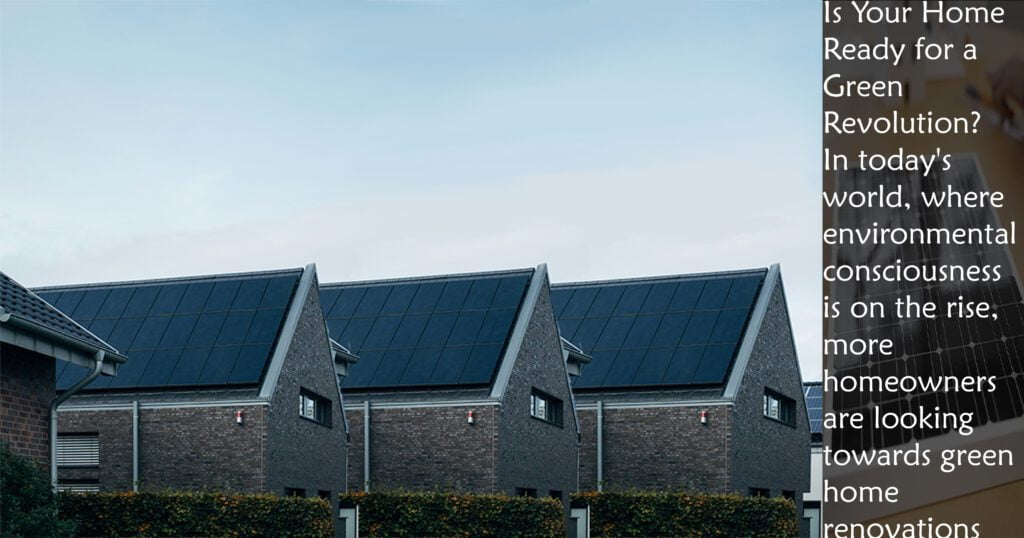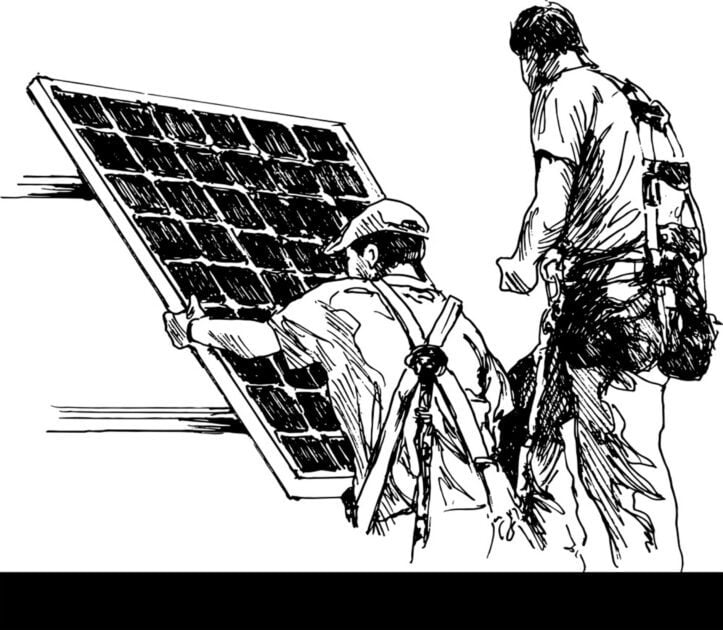10 Innovative Green Home Renovations for a Greener Tomorrow
Is Your Home Ready for a Green Revolution?
In today’s world, where environmental consciousness is on the rise, more homeowners are looking towards green home renovations as a way to reduce their carbon footprint and make their homes more energy-efficient. One of the key components of green home renovations is solar installation, which can significantly reduce energy costs and reliance on non-renewable energy sources. Imagine a home that not only reflects your style but also contributes positively to the environment. Green home renovations offer a sustainable solution, with solar installation leading the charge towards energy efficiency and cost savings. Are you ready to join the green revolution and transform your home into a beacon of sustainability?

Exploring Different Types of Solar Panels
When it comes to choosing solar panels for your home, there are several types to consider:
Monocrystalline Panels: These panels are known for their high efficiency and sleek design. They are a great option if you have limited roof space but want to maximize energy production. Monocrystalline panels are made from single-crystal silicon, making them more efficient in converting sunlight into electricity compared to other types of panels.
Polycrystalline Panels: While slightly less efficient than monocrystalline panels, polycrystalline panels are a more budget-friendly option. They are made from multiple silicon crystals, which makes them less expensive to produce. Polycrystalline panels are a good choice for homeowners looking to save money upfront.
Thin-Film Panels: These panels are lightweight and flexible, making them suitable for unconventional installation areas. Thin-film panels are made by depositing a thin layer of photovoltaic material onto a substrate. While they may be less efficient than crystalline panels, they offer more flexibility in terms of placement.
Important Considerations Before Installing Solar Panels
Before you decide to install solar panels, there are a few key factors to keep in mind:
Roof Suitability: Make sure your roof is in good condition and receives adequate sunlight throughout the day to maximize the efficiency of your solar panels. A south-facing roof with minimal shading is ideal for solar panel installation.
Energy Needs: Consider your current and future energy needs to determine the size and capacity of the solar panel system that will best suit your home. An energy audit can help you understand your energy consumption patterns and determine the appropriate size of your solar panel system.
The Solar Panel Installation Process

Installing solar panels involves several steps:
Site Assessment: A solar installer will assess your property to determine the best location for solar panel installation and evaluate any potential shading issues. They will also evaluate your roof’s structural integrity to ensure it can support the weight of the solar panels.
Permitting: You’ll need to obtain permits from your local government or homeowners’ association before installing solar panels on your property. The permitting process ensures that your solar panel system complies with local building codes and regulations.
Installation: Solar panels are mounted on your roof or in your yard, and the wiring is connected to your home’s electrical system. The installation process typically takes one to three days, depending on the size of your solar panel system.
Inspection: After installation, your solar panel system will be inspected to ensure it meets safety standards and building codes. An inspector will check the wiring, mounting, and overall system performance to ensure everything is functioning properly.
Maintaining Your Solar Panels for Optimal Performance
To ensure your solar panels operate efficiently, regular maintenance is key:
Regular Cleaning: Cleaning your solar panels regularly to remove dirt and debris will help maintain their efficiency. Use a soft brush or cloth and mild detergent to clean the panels, and avoid using abrasive materials that could scratch the surface.
Monitoring Performance: Keep track of your solar panel system’s performance to detect any issues early and maximize energy production. Many solar panel systems come with monitoring software that allows you to track your system’s energy production and efficiency.
Addressing Common Issues: Be aware of common issues such as inverter problems or wiring issues and address them promptly to avoid downtime. If you notice a significant decrease in your solar panel system’s performance, contact your solar installer to diagnose and fix the issue.
Financial Incentives and Rebates for Solar Energy
There are several financial incentives and rebates available to homeowners who install solar panels:
Federal Tax Credits: The federal government offers a tax credit of up to 26% of the cost of solar panel installation. This tax credit applies to both residential and commercial solar panel systems and can significantly reduce the upfront cost of solar panel installation.
State and Local Incentives: Many states and local governments offer additional incentives, such as rebates or grants, to encourage solar panel installation. These incentives vary by location, so it’s important to check with your state and local government for available programs.
Financing Options: Various financing options, such as solar loans or leases, are available to help homeowners afford solar panel installation. These financing options allow you to spread the cost of solar panel installation over time, making it more affordable for many homeowners.
Environmental Benefits of Solar Energy

Using solar energy has many benefits for the environment:
Reduced Carbon Emissions: Solar energy reduces the reliance on fossil fuels, leading to a reduction in greenhouse gas emissions. By using solar energy to power your home, you can significantly reduce your carbon footprint and help combat climate change.
Preservation of Natural Resources: Solar energy helps preserve natural resources such as coal, oil, and natural gas. By using solar energy instead of fossil fuels, you can help reduce the demand for these finite resources and ensure they are available for future generations.
Wildlife Protection: Solar energy production does not harm wildlife or disrupt ecosystems, making it a more environmentally friendly option. Unlike fossil fuel extraction and combustion, solar energy production does not require drilling, mining, or other activities that can harm wildlife habitats.
Real-Life Examples of Successful Solar Installations
Here are some real-life examples of how solar panels have helped people:
Energy Savings: People have saved a significant amount of energy and money by using solar panels. By generating their own electricity from the sun, homeowners can reduce or eliminate their monthly electricity bills, saving them hundreds or even thousands of dollars per year.
Homeowner Satisfaction: Homeowners who have installed solar panels are satisfied with their decision and share their positive experiences. Many homeowners report feeling good about their decision to go solar, knowing that they are reducing their carbon footprint and contributing to a more sustainable future.
Future Trends in Solar Technology
Solar technology is constantly evolving. Here’s what we can expect in the future:
Increased Efficiency: Solar panels will become even more efficient, saving more energy and money. Advances in solar panel technology, such as improved cell efficiency and panel design, will make solar panels more efficient and cost-effective.
Smart Integration: Solar panels will be more integrated with smart home technology, making them easier to use and monitor. Smart solar panel systems will be able to communicate with other smart home devices, such as thermostats and appliances, to optimize energy use and maximize savings.
Conclusion of Green Home Renovations
Your home can be more than just a place to live—it can be a way to help the planet. Green home renovations, like adding solar panels, can make your home more energy-efficient and save you money. By understanding the different types of solar panels, how to install them, and the benefits they offer, you can make your home a beacon of sustainability. Embrace green home renovations and solar energy to make a positive impact on the planet and create a more energy-efficient home for yourself and future generations.
FAQs
1. What are green home renovations?
Green home renovations are home improvement projects that focus on making your home more energy-efficient, environmentally friendly, and sustainable. These renovations often involve using eco-friendly materials, implementing energy-efficient systems, and reducing your home’s overall carbon footprint.
2. Why should I consider green home renovations?
Green home renovations offer several benefits, including reduced energy costs, increased home value, improved indoor air quality, and a lower environmental impact. Additionally, many governments and organizations offer incentives and rebates for eco-friendly home improvements.
3. What are some common green home renovations?
Some common green home renovations include installing solar panels, upgrading to energy-efficient appliances, improving insulation, using sustainable building materials, and implementing smart home technologies for better energy management.
4. How much do green home renovations cost?
The cost of green home renovations can vary depending on the scope of the project and the materials used. While some eco-friendly upgrades may have a higher upfront cost, they can result in long-term savings through reduced energy bills and maintenance costs.
5. Are there any financial incentives for green home renovations?
Yes, there are several financial incentives available for green home renovations, including tax credits, rebates, and grants. These incentives can help offset the initial cost of eco-friendly upgrades and make them more affordable for homeowners.
6. How can I find a contractor for green home renovations?
When looking for a contractor for green home renovations, it’s important to find someone who is experienced in eco-friendly building practices. You can search for contractors who specialize in sustainable construction or green building certifications.
7. What are some tips for planning a green home renovation? When planning a green home renovation, consider your energy needs, budget, and the environmental impact of your choices. Start by conducting an energy audit to identify areas where you can improve efficiency, and prioritize upgrades that will have the biggest impact.
8. How can I ensure that my green home renovation is environmentally friendly?
To ensure that your green home renovation is environmentally friendly, choose eco-friendly materials, recycle or repurpose existing materials where possible, and minimize waste. You can also consider installing energy-efficient appliances and systems to further reduce your home’s environmental impact.
9. Are there any green home renovation trends I should be aware of?
Some current green home renovation trends include the use of sustainable and recycled materials, the integration of smart home technologies for energy management, and the adoption of passive design principles to improve energy efficiency.
10. What are the long-term benefits of green home renovations?
The long-term benefits of green home renovations include lower energy bills, increased home value, improved indoor air quality, and a reduced environmental impact. Additionally, eco-friendly upgrades can create a healthier and more comfortable living environment for you and your family.
These FAQs provide concise answers to common questions about green home renovations, helping you understand the benefits and considerations of eco-friendly home improvements.
One Response